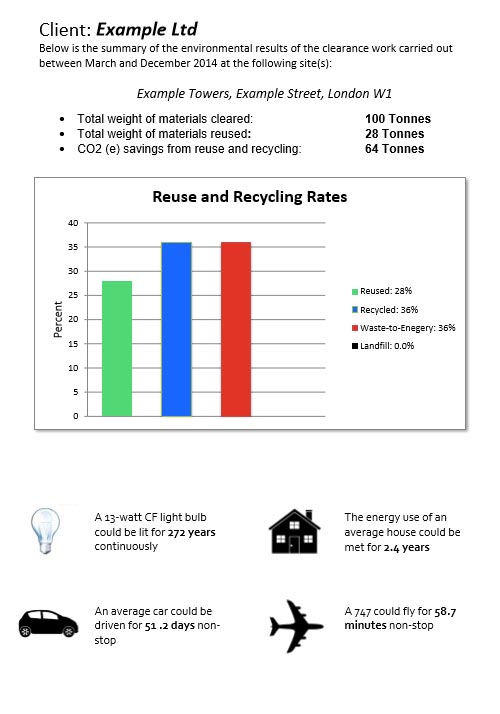Sustainability
Explaining The Sustainable Clearance Process
Evolve has a sustainable, zero-to-landfill approach to clearance of your unwanted office furniture, equipment, IT and waste. Our methods are fully compliant with all waste legislation, constitute best practice and fulfill your Duty of Care.
Re-use and recycling = cost savings (and environmental benefits)
By concentrating on re-use and recycling, we reduce disposal charges and generate revenue through the sale of assets. So being green is good for the environment and saves money.
Our Approach
Whether you need a few surplus items removed, or a large office completely cleared, we implement the following process in accordance with the Waste Hierarchy.
Reuse
Purchase of Assets
We buy suitable assets, such as furniture and IT.
Donations to good causes
Our parent company Clearance Solutions Ltd is a member of the London Community Resource Network. Membership is achieved by having a proven record of donating to charity. We work with the LCRN to find new homes for good quality furniture.
We encourage the recipients to provide details of the donations to the donor organization.
Shipping furniture overseas
We also have a network of overseas shippers who supply customers in countries such as Ethiopia, Senegal and Ghana. This increases reuse rates as there is demand in these countries for furniture that isn’t in demand here in the UK.
Recycling
All remaining waste is sorted into distinct waste streams on-site (such as metal, paper, wood, etc.). It is then transported to the appropriate facility for recycling.
This helps achieve higher recycling rates than simply depositing all the materials as mixed general recycling at Waste Transfer Stations. It also helps make our post project Environmental Reports more accurate.
Some items, such as sofas, are not suitable for onsite separation because they contain a mixture of recyclable and non-recyclable materials. These items are taken to Waste Transfer Stations where they are mechanically separated.
Although on average 60% of these mixed materials are recycled, we don’t count them as recycled in order to maintain the integrity of our Environmental Reports.
Waste-to-Energy
Waste Transfer Stations (WTS)
We use WTS that operate a zero landfill policy. We regularly check the WTS we use to ensure their procedures are in accordance with our policies. However in some circumstances, when we are working in an area where the closest facility does not use a ‘closed loop’ approach, we will inform clients, and offer alternative options.
Environmental Report
Our post project Environmental Reports are based on the methodology pioneered by Dr Adrian Chapman for the The Centre for Remanufacture and Re- use.
The reports detail the total quantities of:-
- Co2 (e) saved through materials reused and recycled
- Materials removed from site
- Materials reused
- Materials recycled
- Materials used in energy recovery
Your Duty of Care and the Waste Hierarchy
Waste in this context is defined as any substance or object that is discarded by the waste producer. It doesn’t matter if it is resold, recycled or deposed of in any other form.
If you have waste you have a legal Duty of Care to ensure it is discarded properly. The Duty of Care applies to everyone involved in handling the waste from the producer of the waste to the establishment that finally uses, recycles or otherwise treats it.
If you intend to instruct a contractor to dispose of waste, it is your duty to:
- Check the contractor has the means to take it
- Ensure the waste goes to an appropriate site
- Give the contractor a Waste Transfer Note (WTN)
- Ensure that a declaration is signed on the WTN to indicate that the Waste Hierarchy has been applied.
We do all the above for you, providing a full audit trail.

